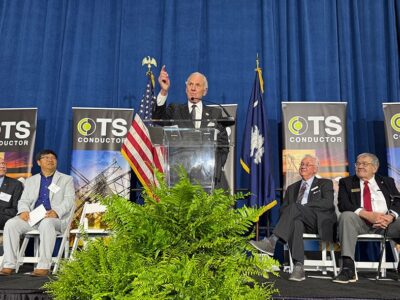One of the biggest impacts of the 2022 Inflation Reduction Act (IRA) is that it incentivized states to take advantage of federal funds designed to boost clean energy programs. Among the early winners is North Carolina, which has seen rapid growth in its clean energy economy as manufacturers from the solar, wind, electric vehicle (EV), and battery storage industries pour money into the state.
An analysis from Climate Power, released in March, ranks North Carolina among the top six states that have benefited from new clean energy projects since the passage of the IRA and other national incentives in 2022, WRAL News reported.
According to Climate Power, the IRA has spurred $18.75 billion in new clean energy investments in North Carolina — the fourth-highest in the country — and led to 9,886 jobs, which ranks ninth nationally.

Photo Courtesy North Carolina Department of Commerce
Those investments are part of a much larger clean energy boom in the Tar Heel State.
A December 2023 press release from the North Carolina Department of Commerce noted that since 2020, North Carolina has announced $42.3 billion worth of clean energy investments expected to create more than 67,000 jobs.
“I want the United States of America to be the majority intellectual property owner for the next generation of energy and climate solutions throughout the world,” shared U.S. Senator Thom Tillis during an event hosted by Consensus this year.

Photo Courtesy Consensus Digital Media
Over the last year or so, North Carolina Gov. Roy Cooper announced 14,114 new clean energy jobs in the state. These jobs represent a combined 134 business recruitment, expansion, or rural development projects in partnership with the Commerce Department. They are expected to inject more than $13 billion of capital investment into the state.
In its new report, Climate Power called North Carolina a “clean energy minerals production powerhouse” whose projects spread across four main areas: batteries, clean technologies, EVs, and grid and transmission. Projects aren’t limited to only urban hubs and higher-income regions, either. As Climate Power noted:
- In North Carolina’s low-income communities, firms have announced “$12.97 billion in investment and the creation of 5,143 good-paying clean energy jobs.”
- “More than 90% of the state’s new investments ($17.01 billion) and 56% of new jobs (5,558)” are in its rural communities.
“The clean energy plan will continue to accelerate the clean energy jobs boom while lowering energy costs for families, investing in disadvantaged communities, and reducing climate pollution across the state,” Climate Power said in its report.

Photo Courtesy North Carolina Department of Commerce
Here’s a look at some of the major clean energy projects in North Carolina since the passage of the IRA, according to Climate Power:
- EV manufacturing. Toyota — the world’s biggest car company — said it plans to invest $13.9 billion in its North Carolina battery manufacturing facility in Liberty, North Carolina. That’s more than 10 times the automaker’s initial investment and more than $10 billion in new financing announced since the IRA’s passage.
- EV charging. In February 2023, Durham, North Carolina-based Kempower credited the IRA for the company’s decision to build a $41 million charging station manufacturing facility in Durham. In May 2023, Italian charger manufacturer Alpitronic said it would construct a $9.3 million technology and repair facility and headquarters in Charlotte, North Carolina, creating 300 new jobs with an average annual salary of more than $90,000. Atom Power announced a pair of expansions at its charger plant in Huntersville, North Carolina, investing $154 million and creating 375 new jobs with an average yearly salary of $92,000.
- Transmission manufacturing. Siemens Energy announced a $149.8 million investment to build large power transformers in Mecklenburg County, creating 475 new manufacturing jobs with salaries above the county average.
- Battery manufacturing. Dai Nippon, a subsidiary of Japan’s DNP Group, announced a $233 million investment to build lithium-ion battery pouches in Linwood, North Carolina, creating 352 jobs with an average annual salary higher than the county average.

Photo Courtesy Kempower





